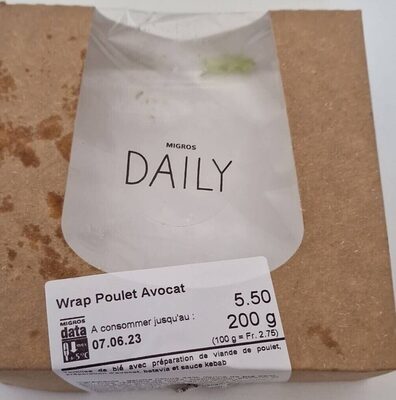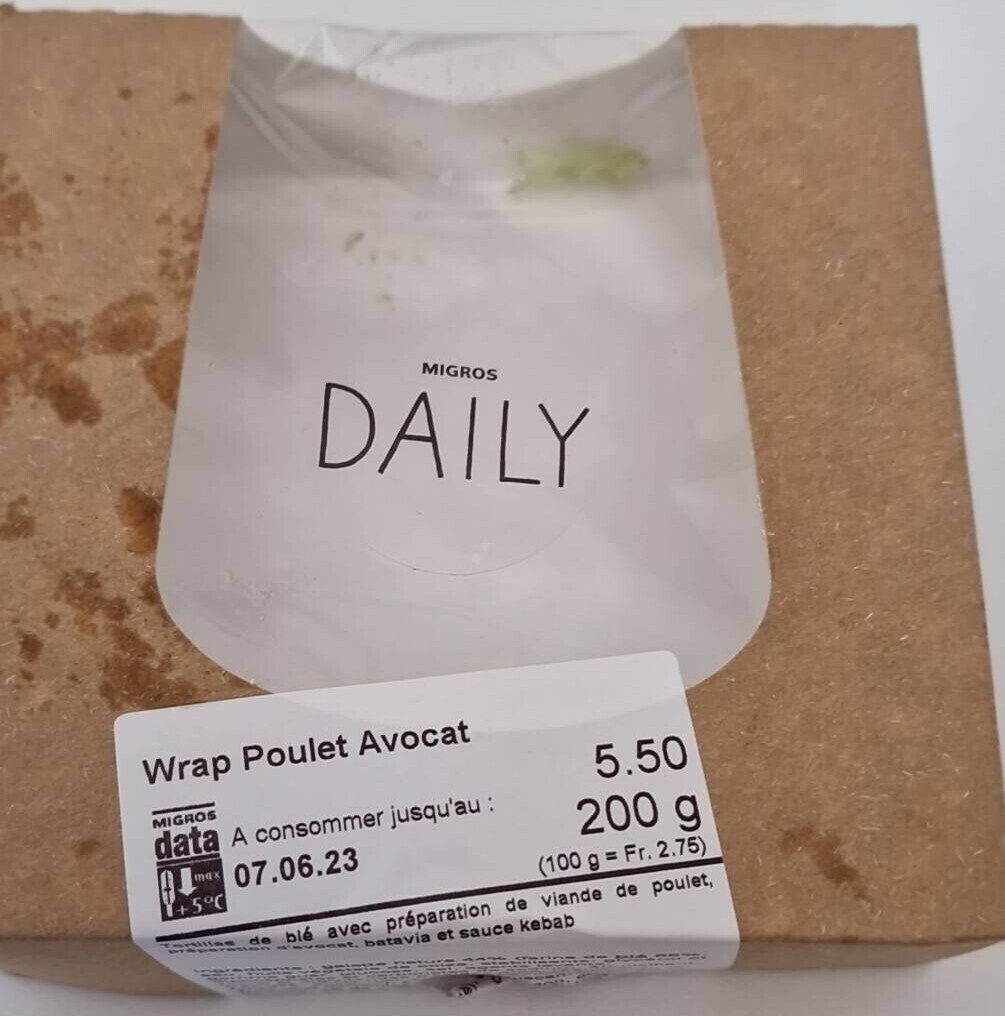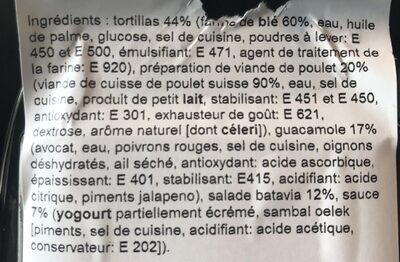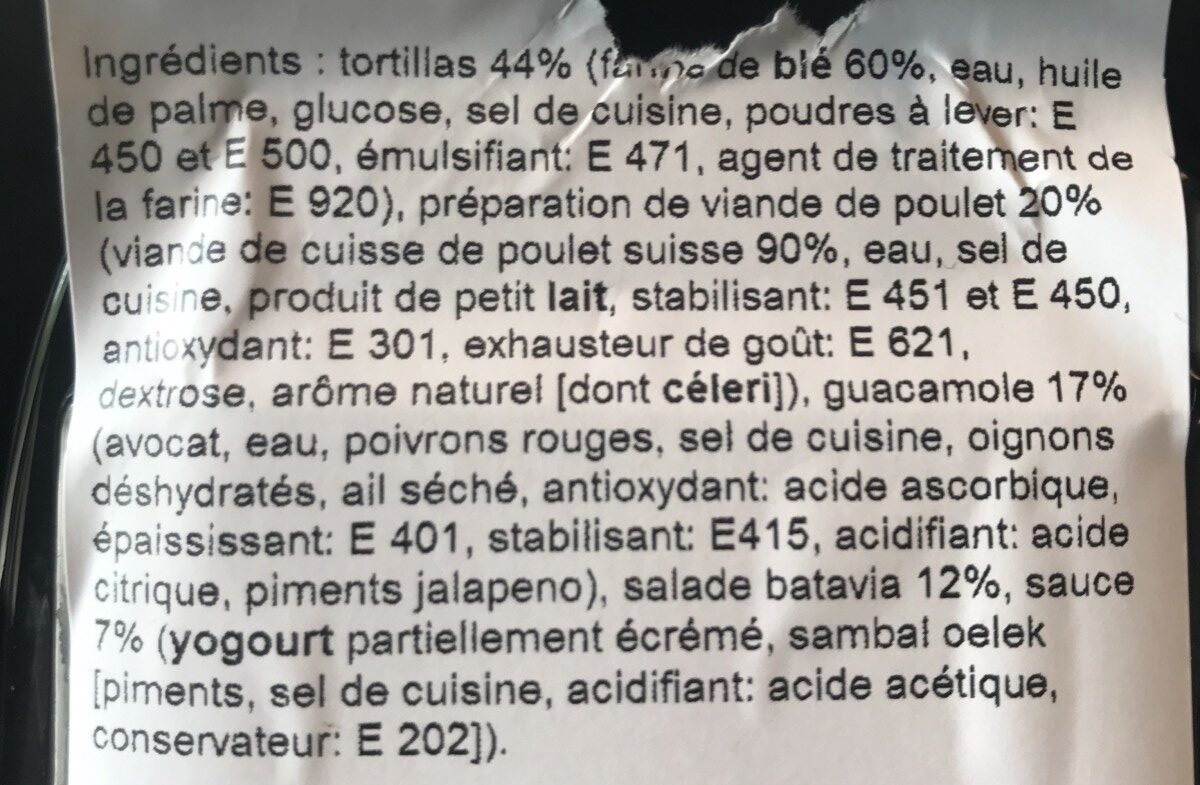Help us make food transparency the norm!
As a non-profit organization, we depend on your donations to continue informing consumers around the world about what they eat.
The food revolution starts with you!
Wrap poulet avocat - Migros
Wrap poulet avocat - Migros
This product page is not complete. You can help to complete it by editing it and adding more data from the photos we have, or by taking more photos using the app for Android or iPhone/iPad. Thank you!
×
Barcode: 7613404026663 (EAN / EAN-13)
Brands: Migros
Categories: Sandwiches, Wraps, Chicken wraps
Stores: Migros
Countries where sold: France
Matching with your preferences
Health
Ingredients
-
53 ingredients
: Ingrédients tortillas 44% (farine de blé 60%, eau, huile de palme, glucose, sel de cuisine, poudres à lever: E 450 et E 500, émulsifiant: E 471, agent de traitement de la farine: E 920), préparation de viande de poulet 20% (viande de cuisse de poulet suisse 90%, eau, sel de cuisine, produit de petit lait, stabilisant: E 451 et E 450, antioxydant: E 301, exhausteur de goût: E 621, dextrose, arôme naturel [dont céleri]), guacamole 17% (avocat, eau, poivrons rouges, sel de cuisine, oignons déshydratés, ail séché, antioxydant: acide ascorbique, épaississant: E 401, stabilisant: E415, acidifiant: acide citrique, piments jalapeno), salade batavia 12%, sauce 7% (yogourt partiellement écrémé, sambal oelek piments, sel de cuisine, acidifiant: acide acétique, conservateur: E 2021)Allergens: Gluten, Milk
Food processing
-
Ultra processed foods
Elements that indicate the product is in the 4 - Ultra processed food and drink products group:
- Additive: E401 - Sodium alginate
- Additive: E415 - Xanthan gum
- Additive: E450 - Diphosphates
- Additive: E451 - Triphosphates
- Additive: E471 - Mono- and diglycerides of fatty acids
- Additive: E621 - Monosodium glutamate
- Ingredient: Dextrose
- Ingredient: Emulsifier
- Ingredient: Flavour enhancer
- Ingredient: Flavouring
- Ingredient: Glucose
- Ingredient: Thickener
- Ingredient: Whey
Food products are classified into 4 groups according to their degree of processing:
- Unprocessed or minimally processed foods
- Processed culinary ingredients
- Processed foods
- Ultra processed foods
The determination of the group is based on the category of the product and on the ingredients it contains.
Additives
-
E260 - Acetic acid
Acetic acid: Acetic acid , systematically named ethanoic acid , is a colorless liquid organic compound with the chemical formula CH3COOH -also written as CH3CO2H or C2H4O2-. When undiluted, it is sometimes called glacial acetic acid. Vinegar is no less than 4% acetic acid by volume, making acetic acid the main component of vinegar apart from water. Acetic acid has a distinctive sour taste and pungent smell. In addition to household vinegar, it is mainly produced as a precursor to polyvinyl acetate and cellulose acetate. It is classified as a weak acid since it only partially dissociates in solution, but concentrated acetic acid is corrosive and can attack the skin. Acetic acid is the second simplest carboxylic acid -after formic acid-. It consists of a methyl group attached to a carboxyl group. It is an important chemical reagent and industrial chemical, used primarily in the production of cellulose acetate for photographic film, polyvinyl acetate for wood glue, and synthetic fibres and fabrics. In households, diluted acetic acid is often used in descaling agents. In the food industry, acetic acid is controlled by the food additive code E260 as an acidity regulator and as a condiment. In biochemistry, the acetyl group, derived from acetic acid, is fundamental to all forms of life. When bound to coenzyme A, it is central to the metabolism of carbohydrates and fats. The global demand for acetic acid is about 6.5 million metric tons per year -Mt/a-, of which approximately 1.5 Mt/a is met by recycling; the remainder is manufactured from methanol. Vinegar is mostly dilute acetic acid, often produced by fermentation and subsequent oxidation of ethanol.Source: Wikipedia
-
E301 - Sodium ascorbate
Sodium ascorbate: Sodium ascorbate is one of a number of mineral salts of ascorbic acid -vitamin C-. The molecular formula of this chemical compound is C6H7NaO6. As the sodium salt of ascorbic acid, it is known as a mineral ascorbate. It has not been demonstrated to be more bioavailable than any other form of vitamin C supplement.Sodium ascorbate normally provides 131 mg of sodium per 1‚000 mg of ascorbic acid -1‚000 mg of sodium ascorbate contains 889 mg of ascorbic acid and 111 mg of sodium-. As a food additive, it has the E number E301 and is used as an antioxidant and an acidity regulator. It is approved for use as a food additive in the EU, USA, and Australia and New Zealand.In in vitro studies, sodium ascorbate has been found to produce cytotoxic effects in various malignant cell lines, which include melanoma cells that are particularly susceptible.Source: Wikipedia
-
E330 - Citric acid
Citric acid is a natural organic acid found in citrus fruits such as lemons, oranges, and limes.
It is widely used in the food industry as a flavor enhancer, acidulant, and preservative due to its tart and refreshing taste.
Citric acid is safe for consumption when used in moderation and is considered a generally recognized as safe (GRAS) food additive by regulatory agencies worldwide.
-
E415 - Xanthan gum
Xanthan gum (E415) is a natural polysaccharide derived from fermented sugars, often used in the food industry as a thickening and stabilizing agent.
This versatile food additive enhances texture and prevents ingredient separation in a wide range of products, including salad dressings, sauces, and gluten-free baked goods.
It is considered safe for consumption even at high intake amounts.
-
E450 - Diphosphates
Diphosphates (E450) are food additives often utilized to modify the texture of products, acting as leavening agents in baking and preventing the coagulation of canned food.
These salts can stabilize whipped cream and are also found in powdered products to maintain their flow properties. They are commonly present in baked goods, processed meats, and soft drinks.
Derived from phosphoric acid, they're part of our daily phosphate intake, which often surpasses recommended levels due to the prevalence of phosphates in processed foods and drinks.
Excessive phosphate consumption is linked to health issues, such as impaired kidney function and weakened bone health. Though diphosphates are generally regarded as safe when consumed within established acceptable daily intakes, it's imperative to monitor overall phosphate consumption to maintain optimal health.
-
E451 - Triphosphates
Sodium triphosphate: Sodium triphosphate -STP-, also sodium tripolyphosphate -STPP-, or tripolyphosphate -TPP-,- is an inorganic compound with formula Na5P3O10. It is the sodium salt of the polyphosphate penta-anion, which is the conjugate base of triphosphoric acid. It is produced on a large scale as a component of many domestic and industrial products, especially detergents. Environmental problems associated with eutrophication are attributed to its widespread use.Source: Wikipedia
-
E471 - Mono- and diglycerides of fatty acids
Mono- and diglycerides of fatty acids (E471), are food additives commonly used as emulsifiers in various processed foods.
These compounds consist of glycerol molecules linked to one or two fatty acid chains, which help stabilize and blend water and oil-based ingredients. E471 enhances the texture and shelf life of products like margarine, baked goods, and ice cream, ensuring a smooth and consistent texture.
It is generally considered safe for consumption within established regulatory limits.
-
E500 - Sodium carbonates
Sodium carbonates (E500) are compounds commonly used in food preparation as leavening agents, helping baked goods rise by releasing carbon dioxide when they interact with acids.
Often found in baking soda, they regulate the pH of food, preventing it from becoming too acidic or too alkaline. In the culinary world, sodium carbonates can also enhance the texture and structure of foods, such as noodles, by modifying the gluten network.
Generally recognized as safe, sodium carbonates are non-toxic when consumed in typical amounts found in food.
-
E621 - Monosodium glutamate
Monosodium glutamate: Monosodium glutamate -MSG, also known as sodium glutamate- is the sodium salt of glutamic acid, one of the most abundant naturally occurring non-essential amino acids. Glutamic acid is found naturally in tomatoes, grapes, cheese, mushrooms and other foods.MSG is used in the food industry as a flavor enhancer with an umami taste that intensifies the meaty, savory flavor of food, as naturally occurring glutamate does in foods such as stews and meat soups. It was first prepared in 1908 by Japanese biochemist Kikunae Ikeda, who was trying to isolate and duplicate the savory taste of kombu, an edible seaweed used as a base for many Japanese soups. MSG as a flavor enhancer balances, blends, and rounds the perception of other tastes.The U.S. Food and Drug Administration has given MSG its generally recognized as safe -GRAS- designation. A popular belief is that large doses of MSG can cause headaches and other feelings of discomfort, known as "Chinese restaurant syndrome," but double-blind tests fail to find evidence of such a reaction. The European Union classifies it as a food additive permitted in certain foods and subject to quantitative limits. MSG has the HS code 29224220 and the E number E621.Source: Wikipedia
-
E920 - L-cysteine
Cysteine: Cysteine -symbol Cys or C; - is a semi-essential proteinogenic amino acid with the formula HO2CCH-NH2-CH2SH. The thiol side chain in cysteine often participates in enzymatic reactions, as a nucleophile. The thiol is susceptible to oxidation to give the disulfide derivative cystine, which serves an important structural role in many proteins. When used as a food additive, it has the E number E920. It is encoded by the codons UGU and UGC. Cysteine has the same structure as serine, but with one of its oxygen atoms replaced by sulfur; replacing it with selenium gives selenocysteine. -Like other natural proteinogenic amino acids cysteine has -L- chirality in the older D/L notation based on homology to D and L glyceraldehyde. In the newer R/S system of designating chirality, based on the atomic numbers of atoms near the asymmetric carbon, cysteine -and selenocysteine- have R chirality, because of the presence of sulfur -resp. selenium- as a second neighbor to the asymmetric carbon. The remaining chiral amino acids, having lighter atoms in that position, have S chirality.-Source: Wikipedia
Ingredients analysis
-
Palm oil
Ingredients that contain palm oil: Palm oil
-
Non-vegan
Non-vegan ingredients: Whey product, fr:Yogourt partiellement écréméSome ingredients could not be recognized.
We need your help!
You can help us recognize more ingredients and better analyze the list of ingredients for this product and others:
- Edit this product page to correct spelling mistakes in the ingredients list, and/or to remove ingredients in other languages and sentences that are not related to the ingredients.
- Add new entries, synonyms or translations to our multilingual lists of ingredients, ingredient processing methods, and labels.
If you would like to help, join the #ingredients channel on our Slack discussion space and/or learn about ingredients analysis on our wiki. Thank you!
-
Vegetarian status unknown
Unrecognized ingredients: fr:ingredients-tortillas, fr:preparation-de-viande-de-poulet, fr:viande-de-cuisse-de-poulet-suisse, fr:guacamole, fr:salade-batavia, fr:sambal-oelek-piments, fr:e2021Some ingredients could not be recognized.
We need your help!
You can help us recognize more ingredients and better analyze the list of ingredients for this product and others:
- Edit this product page to correct spelling mistakes in the ingredients list, and/or to remove ingredients in other languages and sentences that are not related to the ingredients.
- Add new entries, synonyms or translations to our multilingual lists of ingredients, ingredient processing methods, and labels.
If you would like to help, join the #ingredients channel on our Slack discussion space and/or learn about ingredients analysis on our wiki. Thank you!
-
Details of the analysis of the ingredients
We need your help!
Some ingredients could not be recognized.
We need your help!
You can help us recognize more ingredients and better analyze the list of ingredients for this product and others:
- Edit this product page to correct spelling mistakes in the ingredients list, and/or to remove ingredients in other languages and sentences that are not related to the ingredients.
- Add new entries, synonyms or translations to our multilingual lists of ingredients, ingredient processing methods, and labels.
If you would like to help, join the #ingredients channel on our Slack discussion space and/or learn about ingredients analysis on our wiki. Thank you!
: Ingrédients tortillas 44% (farine de blé 26.4%, eau, huile de palme, glucose, sel de cuisine, poudres à lever (e450), e500, émulsifiant (e471), agent de traitement de la farine (e920)), préparation de viande de poulet 20% (viande de cuisse de poulet suisse 18%, eau, sel de cuisine, produit de petit lait, stabilisant (e451), e450, antioxydant (e301), exhausteur de goût (e621), dextrose, arôme naturel (dont céleri)), guacamole 17% (avocat, eau, poivrons rouges, sel de cuisine, oignons déshydratés, ail séché, antioxydant (acide ascorbique), épaississant (e401), stabilisant (e415), acidifiant (acide citrique), piments jalapeno), salade batavia 12%, sauce 7% (yogourt partiellement écrémé, sambal oelek piments, sel de cuisine, acidifiant (acide acétique), conservateur (e2021))- Ingrédients tortillas -> fr:ingredients-tortillas - percent_min: 44 - percent: 44 - percent_max: 44
- farine de blé -> en:wheat-flour - vegan: yes - vegetarian: yes - ciqual_proxy_food_code: 9410 - percent_min: 26.4 - percent: 26.4 - percent_max: 26.4
- eau -> en:water - vegan: yes - vegetarian: yes - ciqual_food_code: 18066 - percent_min: 2.2 - percent_max: 17.6
- huile de palme -> en:palm-oil - vegan: yes - vegetarian: yes - from_palm_oil: yes - ciqual_food_code: 16129 - percent_min: 0 - percent_max: 14.6666666666667
- glucose -> en:glucose - vegan: yes - vegetarian: yes - ciqual_proxy_food_code: 31016 - percent_min: 0 - percent_max: 7.7
- sel de cuisine -> en:salt - vegan: yes - vegetarian: yes - ciqual_food_code: 11058 - percent_min: 0 - percent_max: 1.2
- poudres à lever -> en:raising-agent - percent_min: 0 - percent_max: 1.2
- e450 -> en:e450 - vegan: yes - vegetarian: yes - percent_min: 0 - percent_max: 1.2
- e500 -> en:e500 - vegan: yes - vegetarian: yes - percent_min: 0 - percent_max: 1.2
- émulsifiant -> en:emulsifier - percent_min: 0 - percent_max: 1.2
- e471 -> en:e471 - vegan: maybe - vegetarian: maybe - from_palm_oil: maybe - percent_min: 0 - percent_max: 1.2
- agent de traitement de la farine -> en:flour-treatment-agent - percent_min: 0 - percent_max: 1.2
- e920 -> en:e920 - vegan: maybe - vegetarian: maybe - percent_min: 0 - percent_max: 1.2
- préparation de viande de poulet -> fr:preparation-de-viande-de-poulet - percent_min: 20 - percent: 20 - percent_max: 20
- viande de cuisse de poulet suisse -> fr:viande-de-cuisse-de-poulet-suisse - percent_min: 18 - percent: 18 - percent_max: 18
- eau -> en:water - vegan: yes - vegetarian: yes - ciqual_food_code: 18066 - percent_min: 0.222222222222222 - percent_max: 2
- sel de cuisine -> en:salt - vegan: yes - vegetarian: yes - ciqual_food_code: 11058 - percent_min: 0 - percent_max: 1.2
- produit de petit lait -> en:whey-product - vegan: no - vegetarian: maybe - percent_min: 0 - percent_max: 0.888888888888889
- stabilisant -> en:stabiliser - percent_min: 0 - percent_max: 0.592592592592593
- e451 -> en:e451 - vegan: yes - vegetarian: yes - percent_min: 0 - percent_max: 0.592592592592593
- e450 -> en:e450 - vegan: yes - vegetarian: yes - percent_min: 0 - percent_max: 0.444444444444445
- antioxydant -> en:antioxidant - percent_min: 0 - percent_max: 0.444444444444445
- e301 -> en:e301 - vegan: yes - vegetarian: yes - percent_min: 0 - percent_max: 0.444444444444445
- exhausteur de goût -> en:flavour-enhancer - percent_min: 0 - percent_max: 0.296296296296296
- e621 -> en:e621 - vegan: yes - vegetarian: yes - percent_min: 0 - percent_max: 0.296296296296296
- dextrose -> en:dextrose - vegan: yes - vegetarian: yes - ciqual_proxy_food_code: 31016 - percent_min: 0 - percent_max: 0.296296296296296
- arôme naturel -> en:natural-flavouring - vegan: maybe - vegetarian: maybe - percent_min: 0 - percent_max: 0.296296296296296
- dont céleri -> en:celery - vegan: yes - vegetarian: yes - ciqual_proxy_food_code: 20055 - percent_min: 0 - percent_max: 0.296296296296296
- guacamole -> fr:guacamole - percent_min: 17 - percent: 17 - percent_max: 17
- avocat -> en:avocado - vegan: yes - vegetarian: yes - percent_min: 1.54545454545455 - percent_max: 17
- eau -> en:water - vegan: yes - vegetarian: yes - ciqual_food_code: 18066 - percent_min: 0 - percent_max: 8.5
- poivrons rouges -> en:red-bell-pepper - vegan: yes - vegetarian: yes - ciqual_food_code: 20087 - percent_min: 0 - percent_max: 5.66666666666667
- sel de cuisine -> en:salt - vegan: yes - vegetarian: yes - ciqual_food_code: 11058 - percent_min: 0 - percent_max: 1.2
- oignons déshydratés -> en:dehydrated-onion - vegan: yes - vegetarian: yes - ciqual_food_code: 20180 - percent_min: 0 - percent_max: 1.2
- ail séché -> en:dried-garlic - vegan: yes - vegetarian: yes - ciqual_food_code: 11023 - percent_min: 0 - percent_max: 1.2
- antioxydant -> en:antioxidant - percent_min: 0 - percent_max: 1.2
- acide ascorbique -> en:e300 - vegan: yes - vegetarian: yes - percent_min: 0 - percent_max: 1.2
- épaississant -> en:thickener - percent_min: 0 - percent_max: 1.2
- e401 -> en:e401 - vegan: yes - vegetarian: yes - percent_min: 0 - percent_max: 1.2
- stabilisant -> en:stabiliser - percent_min: 0 - percent_max: 1.2
- e415 -> en:e415 - vegan: yes - vegetarian: yes - percent_min: 0 - percent_max: 1.2
- acidifiant -> en:acid - percent_min: 0 - percent_max: 1.2
- acide citrique -> en:e330 - vegan: yes - vegetarian: yes - percent_min: 0 - percent_max: 1.2
- piments jalapeno -> en:jalapeno-pepper - vegan: yes - vegetarian: yes - ciqual_food_code: 20151 - percent_min: 0 - percent_max: 1.2
- salade batavia -> fr:salade-batavia - percent_min: 12 - percent: 12 - percent_max: 12
- sauce -> en:sauce - vegan: maybe - vegetarian: maybe - percent_min: 7 - percent: 7 - percent_max: 7
- yogourt partiellement écrémé -> fr:yogourt-partiellement-ecreme - vegan: no - vegetarian: yes - ciqual_proxy_food_code: 19593 - percent_min: 1.4 - percent_max: 7
- sambal oelek piments -> fr:sambal-oelek-piments - percent_min: 0 - percent_max: 3.5
- sel de cuisine -> en:salt - vegan: yes - vegetarian: yes - ciqual_food_code: 11058 - percent_min: 0 - percent_max: 1.2
- acidifiant -> en:acid - percent_min: 0 - percent_max: 1.2
- acide acétique -> en:e260 - vegan: yes - vegetarian: yes - percent_min: 0 - percent_max: 1.2
- conservateur -> en:preservative - percent_min: 0 - percent_max: 1.2
- e2021 -> fr:e2021 - percent_min: 0 - percent_max: 1.2
Nutrition
-
Good nutritional quality
⚠ ️Warning: the amount of fruits, vegetables and nuts is not specified on the label, it was estimated from the list of ingredients: 12This product is not considered a beverage for the calculation of the Nutri-Score.
Positive points: 6
- Proteins: 5 / 5 (value: 9, rounded value: 9)
- Fiber: 1 / 5 (value: 1, rounded value: 1)
- Fruits, vegetables, nuts, and colza/walnut/olive oils: 0 / 5 (value: 12.2002683080808, rounded value: 12.2)
Negative points: 7
- Energy: 2 / 10 (value: 833, rounded value: 833)
- Sugars: 0 / 10 (value: 2.5, rounded value: 2.5)
- Saturated fat: 0 / 10 (value: 1, rounded value: 1)
- Sodium: 5 / 10 (value: 480, rounded value: 480)
The points for proteins are counted because the negative points are less than 11.
Nutritional score: (7 - 6)
Nutri-Score:
-
Nutrient levels
-
Fat in moderate quantity (7%)
What you need to know- A high consumption of fat, especially saturated fats, can raise cholesterol, which increases the risk of heart diseases.
Recommendation: Limit the consumption of fat and saturated fat- Choose products with lower fat and saturated fat content.
-
Saturated fat in low quantity (1%)
What you need to know- A high consumption of fat, especially saturated fats, can raise cholesterol, which increases the risk of heart diseases.
Recommendation: Limit the consumption of fat and saturated fat- Choose products with lower fat and saturated fat content.
-
Sugars in low quantity (2.5%)
What you need to know- A high consumption of sugar can cause weight gain and tooth decay. It also augments the risk of type 2 diabetes and cardio-vascular diseases.
Recommendation: Limit the consumption of sugar and sugary drinks- Sugary drinks (such as sodas, fruit beverages, and fruit juices and nectars) should be limited as much as possible (no more than 1 glass a day).
- Choose products with lower sugar content and reduce the consumption of products with added sugars.
-
Salt in moderate quantity (1.2%)
What you need to know- A high consumption of salt (or sodium) can cause raised blood pressure, which can increase the risk of heart disease and stroke.
- Many people who have high blood pressure do not know it, as there are often no symptoms.
- Most people consume too much salt (on average 9 to 12 grams per day), around twice the recommended maximum level of intake.
Recommendation: Limit the consumption of salt and salted food- Reduce the quantity of salt used when cooking, and don't salt again at the table.
- Limit the consumption of salty snacks and choose products with lower salt content.
-
-
Nutrition facts
Nutrition facts As sold
for 100 g / 100 mlCompared to: Chicken wraps Energy 833 kj
(199 kcal)-9% Fat 7 g -21% Saturated fat 1 g -50% Carbohydrates 23 g -3% Sugars 2.5 g -11% Fiber 1 g -53% Proteins 9 g -5% Salt 1.2 g +19% Fruits‚ vegetables‚ nuts and rapeseed‚ walnut and olive oils (estimate from ingredients list analysis) 12.2 %
Environment
-
Eco-Score not computed - Unknown environmental impact
We could not compute the Eco-Score of this product as it is missing some data, could you help complete it?Could you add a precise product category so that we can compute the Eco-Score? Add a category
Packaging
-
Missing packaging information for this product
⚠ ️ The information about the packaging of this product is not filled in.Take a photo of the recycling information Take a photo of the recycling information
Transportation
-
Origins of ingredients
Missing origins of ingredients information
⚠ ️ The origins of the ingredients of this product are not indicated.
If they are indicated on the packaging, you can modify the product sheet and add them.
If you are the manufacturer of this product, you can send us the information with our free platform for producers.Add the origins of ingredients for this product Add the origins of ingredients for this product
Threatened species
-
Contains palm oil
Drives deforestation and threatens species such as the orangutan
Tropical forests in Asia, Africa and Latin America are destroyed to create and expand oil palm tree plantations. The deforestation contributes to climate change, and it endangers species such as the orangutan, the pigmy elephant and the Sumatran rhino.
Report a problem
-
Incomplete or incorrect information?
Category, labels, ingredients, allergens, nutritional information, photos etc.
If the information does not match the information on the packaging, please complete or correct it. Open Food Facts is a collaborative database, and every contribution is useful for all.
Data sources
Product added on by kiliweb
Last edit of product page on by roboto-app.
Product page also edited by autorotate-bot, charlesnepote, openfoodfacts-contributors, sebleouf, sergei, yuka.WWJzNU1vSWRoOVlCb3NkbjIwN2IrdkI1K1k3elJreXFFZkFjSVE9PQ, yuka.sY2b0xO6T85zoF3NwEKvlnVEUfjl-yqeZyP5okSilt3RCc3qX81o45TAbqs.










